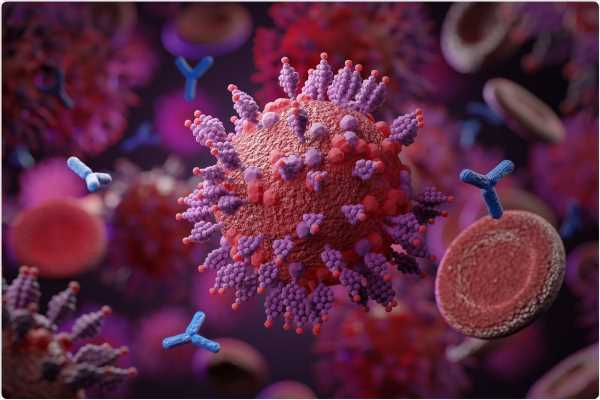A recent Nature Reviews Microbiology article provides evidence for and against the hypothesis of severe acute respiratory syndrome coronavirus 2 (SARS-CoV-2) serotypes, as well as the significance of this categorization. A serotype is a characteristic that can be used to distinguish the humoral immune response initiated by one microorganism as compared to another within a specified species.
The SARS-CoV-2 Omicron variant, for example, consists of several mutations that have enhanced its fitness and infectivity as compared to other SARS-CoV-2 variants. The extent of Omicron's immune evasion capabilities, therefore, supports the discussion of whether it should be designated as a unique SARS-CoV-2 serotype.
.jpg)
Study: Towards SARS-CoV-2 serotypes? Image Credit: Fit Ztudio / Shutterstock.com
Phylogenetic analysis
Viral evolution can either occur as a result of the gradual accumulation of mutations, which commonly occurs in the major circulating lineages over time or due to an evolutionary jump, wherein a cluster of modifications has emerged in new viral variants.
Since its first identification in December 2019, SARS-CoV-2 has mutated into several variants that have been characterized by the World Health Organization (WHO) as variants of concern (VOCs) or variants of interest (VOIs). As of February 2022, five SARS-CoV-2 VOCs have been identified, which include the Alpha, Beta, Gamma, Delta, and Omicron variants.
As compared to the original SARS-CoV-2 sequence, the first Omicron variant (BA.1) contains 54 mutations and seven indels, over 50% of which are present within its spike protein. Several additional sub-lineages of Omicron have been identified, including the BA.2 and BA.3 strains. BA.2 and BA.3 share a majority of their mutations with the BA.1 strain; however, each of these sub-lineages also consists of their own unique mutations that may have developed as a result of recombination.
The BA.1 receptor-binding domain (RBD), which is located within the S1 subunit of the spike protein, acquired 15 of the 34 amino acid changes that occurred within the spike protein of this variant. Notably, 14 of these 15 mutations within the RBD are shared between BA.2 and BA.3. This is comparable to the 8-12 mutations that were present within the spike proteins of previous SARS-CoV-2 VOCs, one to three of which were present within the RBD of these variants.
Limited antibody cross-reactivity
Aside from surface antigens playing a role in serotype classification, another important component of a microbial serotype is that antibodies developed against previous variants do not efficiently cross-react against these lineages.
To this end, several previous studies have demonstrated that the SARS-CoV-2 Omicron variant is resistant to neutralization by antibodies derived from the previous infection. However, a third booster dose of current COVID-19 vaccines, vaccination of previously infected patients, or SARS-CoV-2 breakthrough infection has been shown to elicit strong and broad neutralizing antibody responses against the SARS-CoV-2 Omicron variant.
Taken together, there is limited real-world information on the neutralizing capacity of antibodies against the SARS-CoV-2 Omicron variant. However, several studies have attempted to better understand how antibodies respond to this variant and evaluate the potential for antibody cross-reactivity.
For example, one study conducted in a small group of individuals demonstrated that their neutralizing potential against the SARS-CoV-2 Delta variant was 2.5-fold lower as compared to the Omicron variant. Furthermore, an in vivo mouse study involving the administration of an Omicron RBD-based mRNA vaccine found that immunized mice successfully generated a strong neutralizing antibody response against the SARS-CoV-2 Omicron variant, but not to any other tested variants.
Taken together, these early studies demonstrate that the antibodies generated against previous SARS-CoV-2 variants are virtually ineffective against the Omicron variant. However, future research is needed to fully elucidate the cross-reactivity of antibodies generated following Omicron infection against other SARS-CoV-2 variants, as well as other Omicron sub-lineages.
Conclusions
One of the advantages associated with classifying SARS-CoV-2 variants into different subtypes is that it may assist in solving some of the challenges currently encountered during the diagnosis and treatment of COVID-19, as well as the development of novel and more efficacious vaccines.
When considering the diagnosis of SARS-CoV-2 variants, certain antigenic tests have been shown to be less sensitive in detecting the Omicron variant. Furthermore, serological tests that have been developed according to the ancestral SARS-CoV-2 genetic sequence may also be limited in their ability to accurately identify specific antibodies generated in response to SARS-CoV-2 Omicron infection.
- Simon-Loriere, E., & Schwartz, O. (2022). Towards SARS-CoV-2 serotypes? Nature Reviews Microbiology. doi:10.1038/s41579-022-00708-x
Posted in: Medical Science News | Medical Research News | Disease/Infection News
Tags: Amino Acid, Antibodies, Antibody, Coronavirus, Coronavirus Disease COVID-19, covid-19, Evolution, Genetic, Immune Response, in vivo, Microbiology, Microorganism, Omicron, Protein, Receptor, Research, Respiratory, SARS, SARS-CoV-2, Severe Acute Respiratory, Severe Acute Respiratory Syndrome, Spike Protein, Syndrome, Vaccine

Written by
Snehal Jamalpure
Snehal Jamalpure is a postgraduate student in Microbial gene technology. Following completion of an M.Sc, she worked as a project fellow at the Council of Scientific and Industrial Research-Centre for Cellular and Molecular Biology in Hyderabad, India. Snehal has hands-on experience in protein-related and DNA-related experiments, cell culture, and handling of pathogenic strains ( Leishmania donovani ) in Biosafety level 3 facilities. Snehal is currently pursuing a Ph.D. in the subject of nanobioscience and is working at the interface of nanotechnology and biology.
Source: Read Full Article
